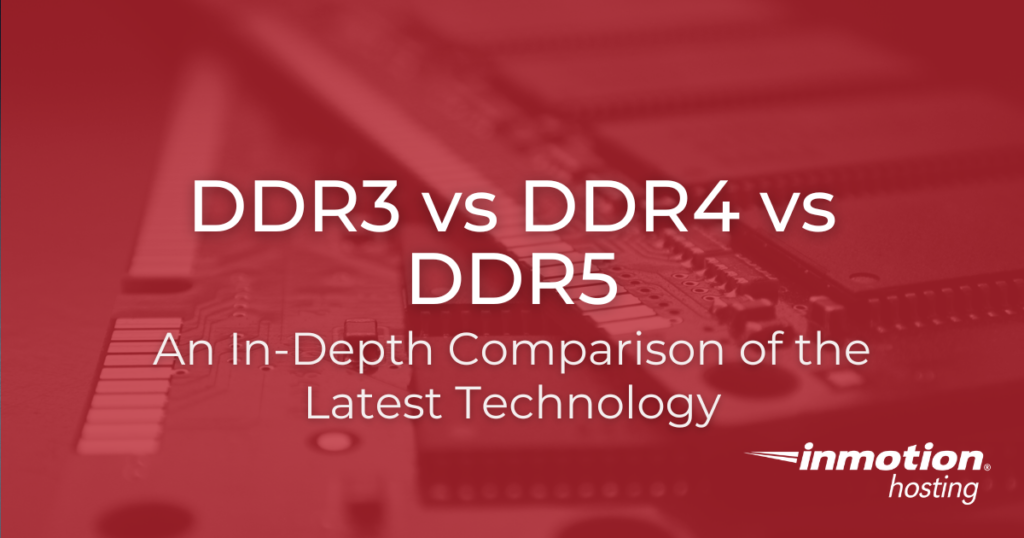Random Access Memory (RAM) significantly impacts your server system’s performance, efficiency, and capabilities. With every technological advancement, new standards and types emerge, offering better performance and lower power consumption.
This blog post will define the latest and most popular types of RAM: DDR3, DDR4, and DDR5. We will review the differences between the three types and how they affect your site’s performance.
Understanding DDR3, DDR4, and DDR5 Memory
To learn the differences between DDR4 and DDR5 vs older generations, we’ll define the three types of RAM and break down their offerings.
What is DDR3 Memory?
DDR3 is the third generation of Double Data Rate (DDR) memory, first introduced in 2007. The new DDR3 Memory offers higher clock speeds (800-2133 MHz), better data bandwidth, and lower power consumption than DDR2. Despite being on the market for a while, it remains a popular choice due to its lower pricing and a reputation for reliability.
What is DDR4 Memory?
DDR4 is the fourth generation of DDR memory, which came to market in 2014 and became widely adopted. It improves on the speed of DDR3, reaching RAM speeds of 1600-3200 MHz, with better transfer bandwidth and energy efficiency, now drawing only 1.2 V. DDR4 is often used in consumer computers and enterprise systems providing a balance of performance and cost.
What is DDR5 Memory?
DDR5 motherboards, introduced in 2020, offer significant improvements over DDR4, making it suitable for high-performance laptops and PCs equipped with Intel processors. When analyzing DDR4 vs DDR5, the latter shows a boost in memory bandwidth. It features speeds starting at 4800 MHz with the potential to reach upwards of 8400 MHz. Likewise, it offers better energy efficiency using only 1.1V and doubles the bandwidth of DDR4. DDR5 is the current standard for true high-performance computing.
DDR3 vs DDR4 vs DDR5
Performance Improvements
Clock Speed and Bandwidth:DDR5 offers the highest bandwidth, enabling superior performance with unprecedented speeds. It opens doors to future innovations and significant improvements in memory performance.
Latency and Efficiency:Latency decreases with higher generations, enhancing performance in demanding applications. This means the information stored in memory can be accessed and processed quickly, leading to faster response times and smoother operations. Lower latency improves resource usage and system performance for high-demand applications like database management or scientific computing.
Power Consumption:DDR3 (1.5V), DDR4 (1.2V), and DDR5 (1.1V) all reduce power requirements, improving energy efficiency and saving on energy consumption with each generation.
Capacity and Density
Maximum Module Sizes:DDR3 can support up to 16 GB of RAM, DDR4 supports up to 64 GB, and DDR5 can support up to 128 GB of RAM. Each generation’s higher density supports larger data transfer and storage, making DDR5 worth the investment for demanding tasks.
Channel Architecture:DDR5’s dual-channel architecture increases data transfer rates and capacity. That is, your server memory has double the amount of channels it can use to process data and requests, a design choice defined by JEDEC for DDR5.
RAM Market and Compatibility
Hardware Compatibility:Upgrading a DDR3 to DDR4 or DDR5 may require a new motherboard and processors. Not all hardware can use all RAM types. Be sure to check your documentation to ensure compatibility with your existing CPU.
Market Availability:DDR3 is still available but user demand is declining due to more manufacturers defaulting to DDR4 or DDR5. In contrast, DDR4 has become more widespread and is likely considered the standard for most people. But, when comparing DDR4 vs DDR5, the latter is gaining traction in large computing and high-end performance builds as its price decreases. It’s expected to become the next standard as it becomes more commonplace.
Why These Differences Matter for Hosting and Large-Scale Computing
Enhanced Performance and Speed
Real-world benchmarks show significant performance gains with each new generation of RAM. The latest RAM has a higher base speed and allows for more memory per module, letting you increase your system’s RAM. Upgrading to newer RAM generations can boost your website’s speed and improve user experience.
Energy Efficiency
Each new generation of RAM is getting faster and providing more memory per module while using less power. They consistently use less energy than the previous generation while delivering better performance. DDR5 can use lower voltage, further enhancing energy savings and an added benefit of using DDR5 compared to DDR4. Over time these savings on power can lower your IT costs.
Enhanced Reliability
DDR5 is expected to improve reliability and data integrity compared to DDR3 and DDR4, due to its use of advanced ECC (Error-correcting code) Technology. DDR5 uses ECC technology on the module, reducing the amount of errors. This results in fewer crashes and downtime, ensuring higher performance and uptime for your sites.
Final Thoughts
The shift from DDR3 to DDR4 to DDR5 progressively boosts server performance, efficiency, and capacity.
DDR3 is still available and cost-effective but offers lower speeds with higher power consumption than newer generations.
DDR4 has become the standard for most consumer and enterprise users. DDR4 RAM provides a balance of speed and power consumption that suits a range of applications, from gaming to business solutions.
DDR5 RAM offers exceptional performance with speeds of up to 8400 MHz and improved energy efficiency. For hosting and large-scale computing, these advancements are critical, particularly in systems utilizing DIMMs with DDR5.
Enhanced performance means faster response time for high-traffic websites and applications. As technology advances, upgrading to newer generations of RAM can boost speed and performance while using less energy, especially with high-end DDR4 and DDR5 modules.
Contact our sales team today to find a server that will fit your needs at a price that works for your bottom line.

